Leadership & Management in Hospitality: Addressing Labor Shortages
VerifiedAdded on 2023/07/10
|7
|2750
|273
Report
AI Summary
This report examines the critical roles of leadership and management in facilitating the recovery of the hospitality sector following the COVID-19 pandemic, with a specific focus on addressing labor shortages. It differentiates between leadership and management, highlighting the importance of both in organizational success. Various leadership models, including solo and collaborative approaches, are discussed, emphasizing the need for adaptability and employee empowerment. The report also explores the qualities of successful managers and leaders, such as charisma, inspirational motivation, and individual consideration. Furthermore, it delves into the concept of learning organizations and the significance of continuous learning and adaptation in a rapidly changing business environment. The importance of team leadership and decentralized decision-making in the education sector is also addressed. The report concludes by emphasizing the need for organizations to cultivate capable leaders who can navigate challenges and inspire their teams to achieve organizational goals.
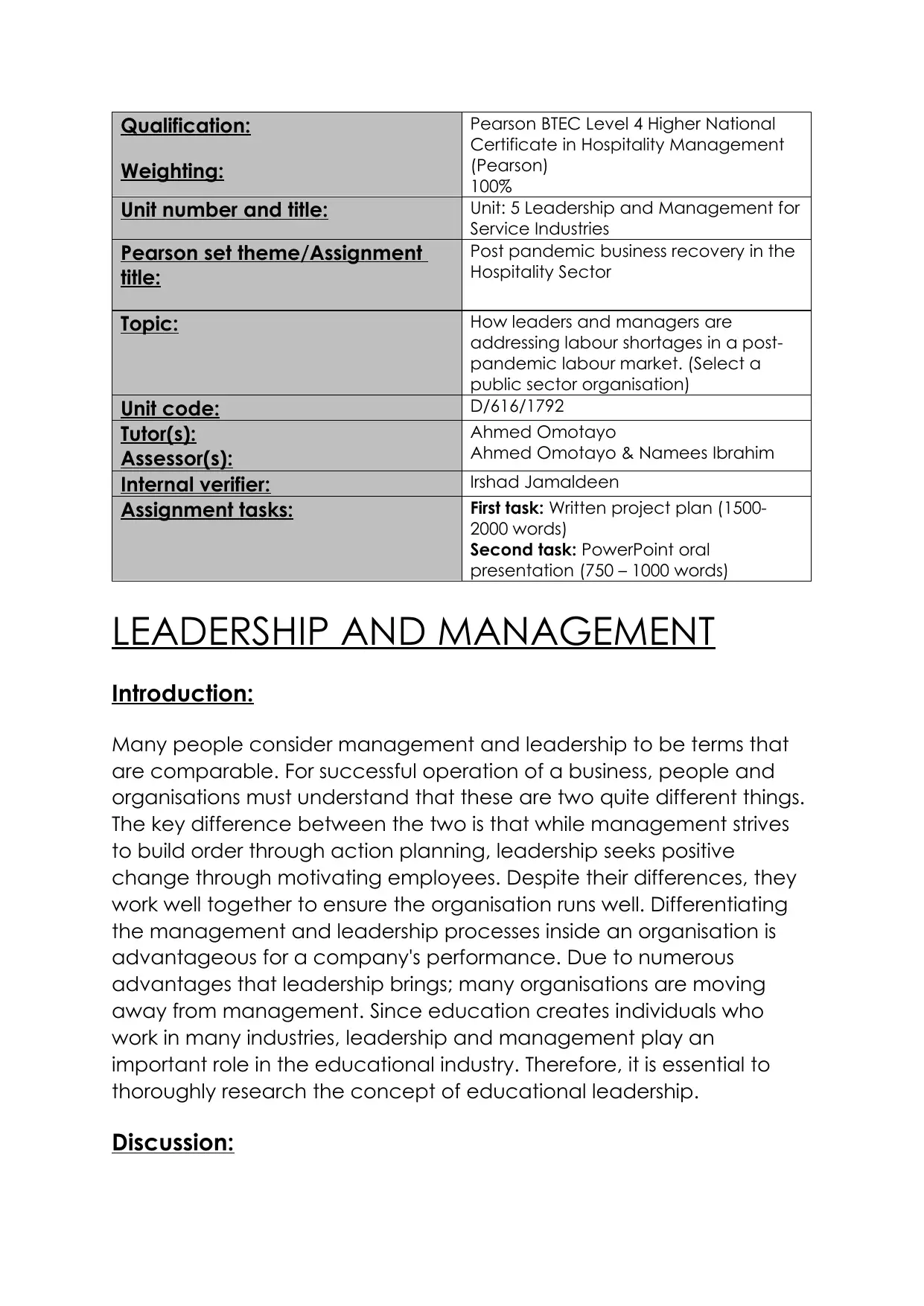
Qualification:
Weighting:
Pearson BTEC Level 4 Higher National
Certificate in Hospitality Management
(Pearson)
100%
Unit number and title: Unit: 5 Leadership and Management for
Service Industries
Pearson set theme/Assignment
title:
Post pandemic business recovery in the
Hospitality Sector
Topic: How leaders and managers are
addressing labour shortages in a post-
pandemic labour market. (Select a
public sector organisation)
Unit code: D/616/1792
Tutor(s):
Assessor(s):
Ahmed Omotayo
Ahmed Omotayo & Namees Ibrahim
Internal verifier: Irshad Jamaldeen
Assignment tasks: First task: Written project plan (1500-
2000 words)
Second task: PowerPoint oral
presentation (750 – 1000 words)
LEADERSHIP AND MANAGEMENT
Introduction:
Many people consider management and leadership to be terms that
are comparable. For successful operation of a business, people and
organisations must understand that these are two quite different things.
The key difference between the two is that while management strives
to build order through action planning, leadership seeks positive
change through motivating employees. Despite their differences, they
work well together to ensure the organisation runs well. Differentiating
the management and leadership processes inside an organisation is
advantageous for a company's performance. Due to numerous
advantages that leadership brings; many organisations are moving
away from management. Since education creates individuals who
work in many industries, leadership and management play an
important role in the educational industry. Therefore, it is essential to
thoroughly research the concept of educational leadership.
Discussion:
Weighting:
Pearson BTEC Level 4 Higher National
Certificate in Hospitality Management
(Pearson)
100%
Unit number and title: Unit: 5 Leadership and Management for
Service Industries
Pearson set theme/Assignment
title:
Post pandemic business recovery in the
Hospitality Sector
Topic: How leaders and managers are
addressing labour shortages in a post-
pandemic labour market. (Select a
public sector organisation)
Unit code: D/616/1792
Tutor(s):
Assessor(s):
Ahmed Omotayo
Ahmed Omotayo & Namees Ibrahim
Internal verifier: Irshad Jamaldeen
Assignment tasks: First task: Written project plan (1500-
2000 words)
Second task: PowerPoint oral
presentation (750 – 1000 words)
LEADERSHIP AND MANAGEMENT
Introduction:
Many people consider management and leadership to be terms that
are comparable. For successful operation of a business, people and
organisations must understand that these are two quite different things.
The key difference between the two is that while management strives
to build order through action planning, leadership seeks positive
change through motivating employees. Despite their differences, they
work well together to ensure the organisation runs well. Differentiating
the management and leadership processes inside an organisation is
advantageous for a company's performance. Due to numerous
advantages that leadership brings; many organisations are moving
away from management. Since education creates individuals who
work in many industries, leadership and management play an
important role in the educational industry. Therefore, it is essential to
thoroughly research the concept of educational leadership.
Discussion:
Paraphrase This Document
Need a fresh take? Get an instant paraphrase of this document with our AI Paraphraser
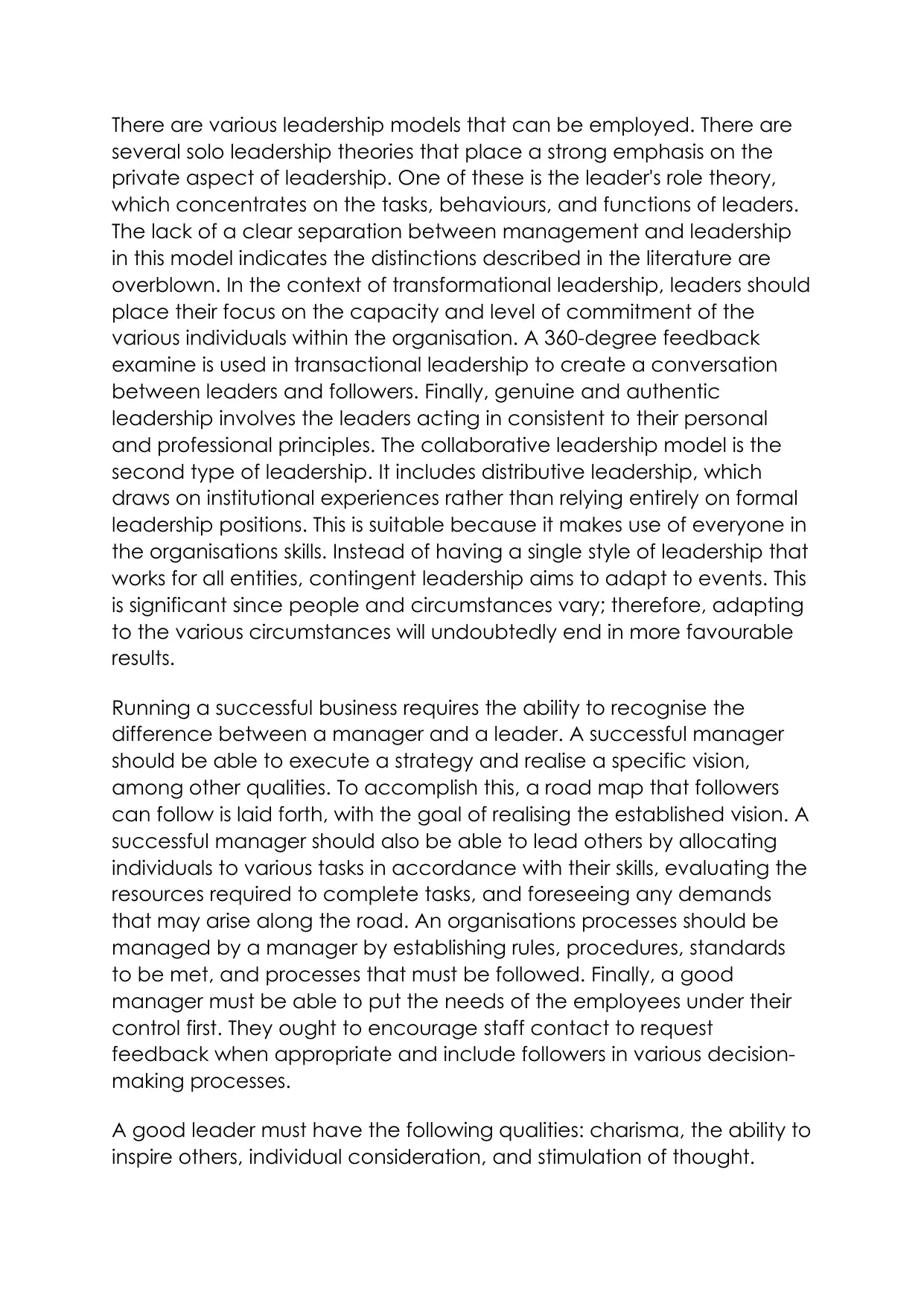
There are various leadership models that can be employed. There are
several solo leadership theories that place a strong emphasis on the
private aspect of leadership. One of these is the leader's role theory,
which concentrates on the tasks, behaviours, and functions of leaders.
The lack of a clear separation between management and leadership
in this model indicates the distinctions described in the literature are
overblown. In the context of transformational leadership, leaders should
place their focus on the capacity and level of commitment of the
various individuals within the organisation. A 360-degree feedback
examine is used in transactional leadership to create a conversation
between leaders and followers. Finally, genuine and authentic
leadership involves the leaders acting in consistent to their personal
and professional principles. The collaborative leadership model is the
second type of leadership. It includes distributive leadership, which
draws on institutional experiences rather than relying entirely on formal
leadership positions. This is suitable because it makes use of everyone in
the organisations skills. Instead of having a single style of leadership that
works for all entities, contingent leadership aims to adapt to events. This
is significant since people and circumstances vary; therefore, adapting
to the various circumstances will undoubtedly end in more favourable
results.
Running a successful business requires the ability to recognise the
difference between a manager and a leader. A successful manager
should be able to execute a strategy and realise a specific vision,
among other qualities. To accomplish this, a road map that followers
can follow is laid forth, with the goal of realising the established vision. A
successful manager should also be able to lead others by allocating
individuals to various tasks in accordance with their skills, evaluating the
resources required to complete tasks, and foreseeing any demands
that may arise along the road. An organisations processes should be
managed by a manager by establishing rules, procedures, standards
to be met, and processes that must be followed. Finally, a good
manager must be able to put the needs of the employees under their
control first. They ought to encourage staff contact to request
feedback when appropriate and include followers in various decision-
making processes.
A good leader must have the following qualities: charisma, the ability to
inspire others, individual consideration, and stimulation of thought.
several solo leadership theories that place a strong emphasis on the
private aspect of leadership. One of these is the leader's role theory,
which concentrates on the tasks, behaviours, and functions of leaders.
The lack of a clear separation between management and leadership
in this model indicates the distinctions described in the literature are
overblown. In the context of transformational leadership, leaders should
place their focus on the capacity and level of commitment of the
various individuals within the organisation. A 360-degree feedback
examine is used in transactional leadership to create a conversation
between leaders and followers. Finally, genuine and authentic
leadership involves the leaders acting in consistent to their personal
and professional principles. The collaborative leadership model is the
second type of leadership. It includes distributive leadership, which
draws on institutional experiences rather than relying entirely on formal
leadership positions. This is suitable because it makes use of everyone in
the organisations skills. Instead of having a single style of leadership that
works for all entities, contingent leadership aims to adapt to events. This
is significant since people and circumstances vary; therefore, adapting
to the various circumstances will undoubtedly end in more favourable
results.
Running a successful business requires the ability to recognise the
difference between a manager and a leader. A successful manager
should be able to execute a strategy and realise a specific vision,
among other qualities. To accomplish this, a road map that followers
can follow is laid forth, with the goal of realising the established vision. A
successful manager should also be able to lead others by allocating
individuals to various tasks in accordance with their skills, evaluating the
resources required to complete tasks, and foreseeing any demands
that may arise along the road. An organisations processes should be
managed by a manager by establishing rules, procedures, standards
to be met, and processes that must be followed. Finally, a good
manager must be able to put the needs of the employees under their
control first. They ought to encourage staff contact to request
feedback when appropriate and include followers in various decision-
making processes.
A good leader must have the following qualities: charisma, the ability to
inspire others, individual consideration, and stimulation of thought.
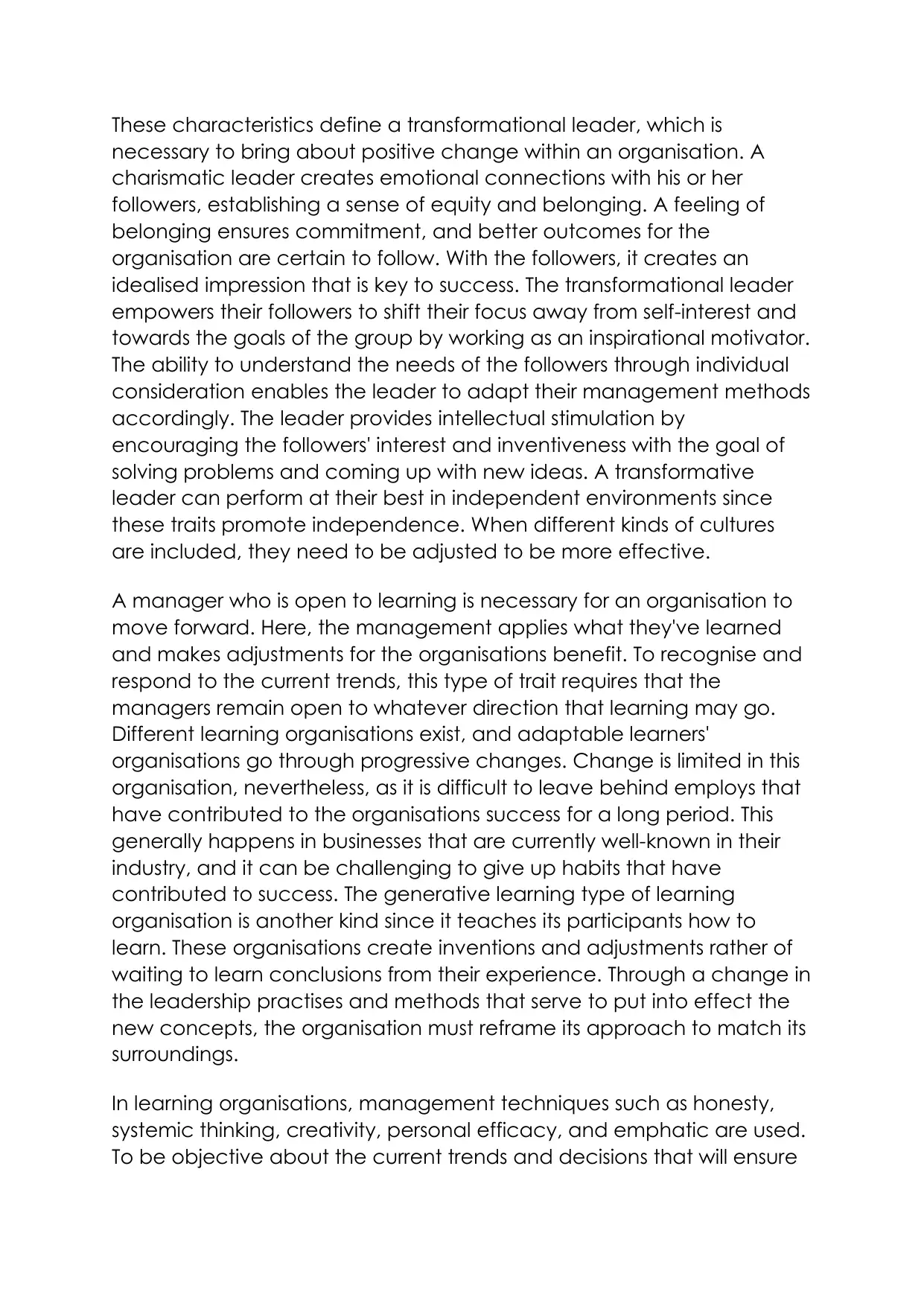
These characteristics define a transformational leader, which is
necessary to bring about positive change within an organisation. A
charismatic leader creates emotional connections with his or her
followers, establishing a sense of equity and belonging. A feeling of
belonging ensures commitment, and better outcomes for the
organisation are certain to follow. With the followers, it creates an
idealised impression that is key to success. The transformational leader
empowers their followers to shift their focus away from self-interest and
towards the goals of the group by working as an inspirational motivator.
The ability to understand the needs of the followers through individual
consideration enables the leader to adapt their management methods
accordingly. The leader provides intellectual stimulation by
encouraging the followers' interest and inventiveness with the goal of
solving problems and coming up with new ideas. A transformative
leader can perform at their best in independent environments since
these traits promote independence. When different kinds of cultures
are included, they need to be adjusted to be more effective.
A manager who is open to learning is necessary for an organisation to
move forward. Here, the management applies what they've learned
and makes adjustments for the organisations benefit. To recognise and
respond to the current trends, this type of trait requires that the
managers remain open to whatever direction that learning may go.
Different learning organisations exist, and adaptable learners'
organisations go through progressive changes. Change is limited in this
organisation, nevertheless, as it is difficult to leave behind employs that
have contributed to the organisations success for a long period. This
generally happens in businesses that are currently well-known in their
industry, and it can be challenging to give up habits that have
contributed to success. The generative learning type of learning
organisation is another kind since it teaches its participants how to
learn. These organisations create inventions and adjustments rather of
waiting to learn conclusions from their experience. Through a change in
the leadership practises and methods that serve to put into effect the
new concepts, the organisation must reframe its approach to match its
surroundings.
In learning organisations, management techniques such as honesty,
systemic thinking, creativity, personal efficacy, and emphatic are used.
To be objective about the current trends and decisions that will ensure
necessary to bring about positive change within an organisation. A
charismatic leader creates emotional connections with his or her
followers, establishing a sense of equity and belonging. A feeling of
belonging ensures commitment, and better outcomes for the
organisation are certain to follow. With the followers, it creates an
idealised impression that is key to success. The transformational leader
empowers their followers to shift their focus away from self-interest and
towards the goals of the group by working as an inspirational motivator.
The ability to understand the needs of the followers through individual
consideration enables the leader to adapt their management methods
accordingly. The leader provides intellectual stimulation by
encouraging the followers' interest and inventiveness with the goal of
solving problems and coming up with new ideas. A transformative
leader can perform at their best in independent environments since
these traits promote independence. When different kinds of cultures
are included, they need to be adjusted to be more effective.
A manager who is open to learning is necessary for an organisation to
move forward. Here, the management applies what they've learned
and makes adjustments for the organisations benefit. To recognise and
respond to the current trends, this type of trait requires that the
managers remain open to whatever direction that learning may go.
Different learning organisations exist, and adaptable learners'
organisations go through progressive changes. Change is limited in this
organisation, nevertheless, as it is difficult to leave behind employs that
have contributed to the organisations success for a long period. This
generally happens in businesses that are currently well-known in their
industry, and it can be challenging to give up habits that have
contributed to success. The generative learning type of learning
organisation is another kind since it teaches its participants how to
learn. These organisations create inventions and adjustments rather of
waiting to learn conclusions from their experience. Through a change in
the leadership practises and methods that serve to put into effect the
new concepts, the organisation must reframe its approach to match its
surroundings.
In learning organisations, management techniques such as honesty,
systemic thinking, creativity, personal efficacy, and emphatic are used.
To be objective about the current trends and decisions that will ensure
⊘ This is a preview!⊘
Do you want full access?
Subscribe today to unlock all pages.

Trusted by 1+ million students worldwide
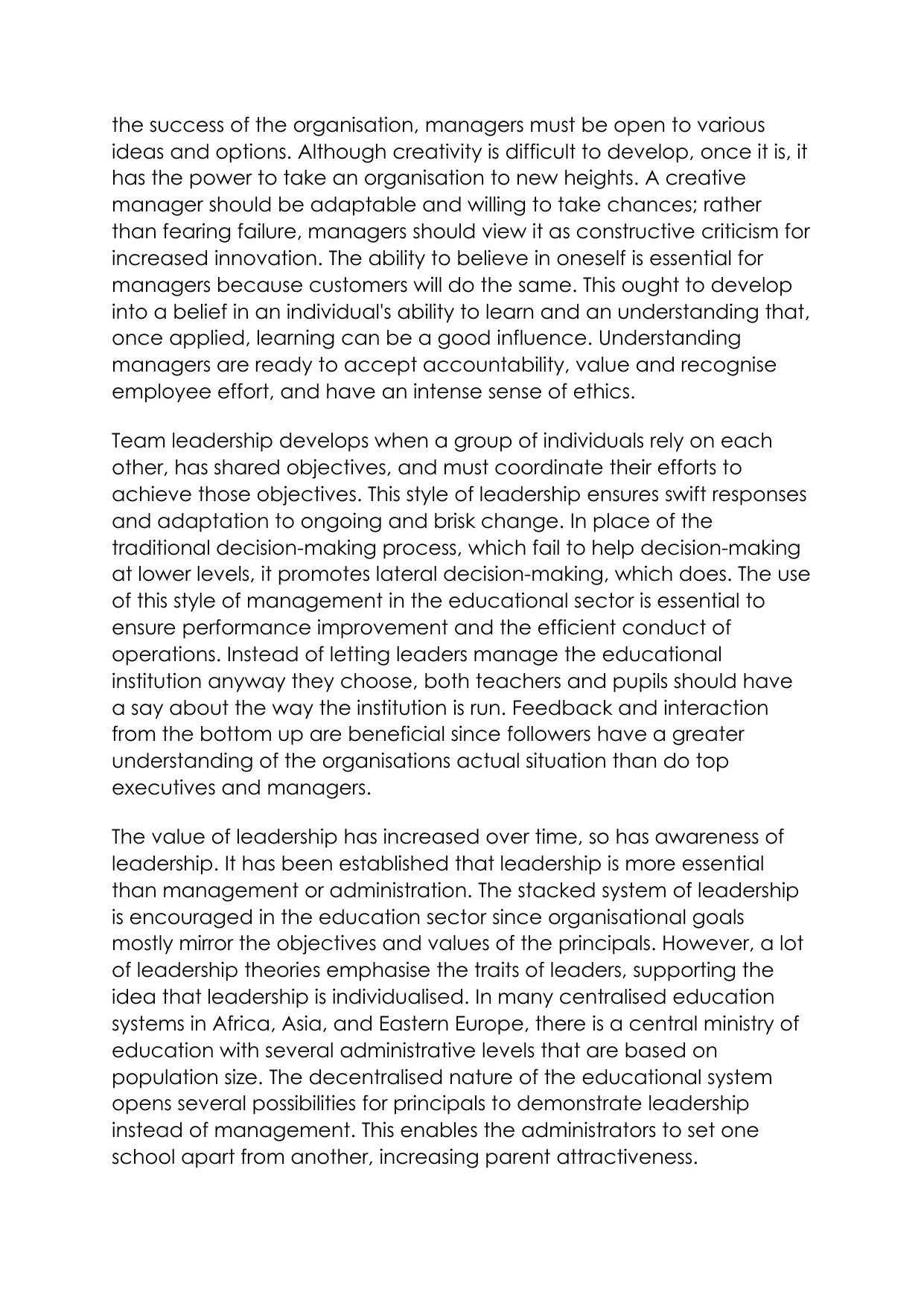
the success of the organisation, managers must be open to various
ideas and options. Although creativity is difficult to develop, once it is, it
has the power to take an organisation to new heights. A creative
manager should be adaptable and willing to take chances; rather
than fearing failure, managers should view it as constructive criticism for
increased innovation. The ability to believe in oneself is essential for
managers because customers will do the same. This ought to develop
into a belief in an individual's ability to learn and an understanding that,
once applied, learning can be a good influence. Understanding
managers are ready to accept accountability, value and recognise
employee effort, and have an intense sense of ethics.
Team leadership develops when a group of individuals rely on each
other, has shared objectives, and must coordinate their efforts to
achieve those objectives. This style of leadership ensures swift responses
and adaptation to ongoing and brisk change. In place of the
traditional decision-making process, which fail to help decision-making
at lower levels, it promotes lateral decision-making, which does. The use
of this style of management in the educational sector is essential to
ensure performance improvement and the efficient conduct of
operations. Instead of letting leaders manage the educational
institution anyway they choose, both teachers and pupils should have
a say about the way the institution is run. Feedback and interaction
from the bottom up are beneficial since followers have a greater
understanding of the organisations actual situation than do top
executives and managers.
The value of leadership has increased over time, so has awareness of
leadership. It has been established that leadership is more essential
than management or administration. The stacked system of leadership
is encouraged in the education sector since organisational goals
mostly mirror the objectives and values of the principals. However, a lot
of leadership theories emphasise the traits of leaders, supporting the
idea that leadership is individualised. In many centralised education
systems in Africa, Asia, and Eastern Europe, there is a central ministry of
education with several administrative levels that are based on
population size. The decentralised nature of the educational system
opens several possibilities for principals to demonstrate leadership
instead of management. This enables the administrators to set one
school apart from another, increasing parent attractiveness.
ideas and options. Although creativity is difficult to develop, once it is, it
has the power to take an organisation to new heights. A creative
manager should be adaptable and willing to take chances; rather
than fearing failure, managers should view it as constructive criticism for
increased innovation. The ability to believe in oneself is essential for
managers because customers will do the same. This ought to develop
into a belief in an individual's ability to learn and an understanding that,
once applied, learning can be a good influence. Understanding
managers are ready to accept accountability, value and recognise
employee effort, and have an intense sense of ethics.
Team leadership develops when a group of individuals rely on each
other, has shared objectives, and must coordinate their efforts to
achieve those objectives. This style of leadership ensures swift responses
and adaptation to ongoing and brisk change. In place of the
traditional decision-making process, which fail to help decision-making
at lower levels, it promotes lateral decision-making, which does. The use
of this style of management in the educational sector is essential to
ensure performance improvement and the efficient conduct of
operations. Instead of letting leaders manage the educational
institution anyway they choose, both teachers and pupils should have
a say about the way the institution is run. Feedback and interaction
from the bottom up are beneficial since followers have a greater
understanding of the organisations actual situation than do top
executives and managers.
The value of leadership has increased over time, so has awareness of
leadership. It has been established that leadership is more essential
than management or administration. The stacked system of leadership
is encouraged in the education sector since organisational goals
mostly mirror the objectives and values of the principals. However, a lot
of leadership theories emphasise the traits of leaders, supporting the
idea that leadership is individualised. In many centralised education
systems in Africa, Asia, and Eastern Europe, there is a central ministry of
education with several administrative levels that are based on
population size. The decentralised nature of the educational system
opens several possibilities for principals to demonstrate leadership
instead of management. This enables the administrators to set one
school apart from another, increasing parent attractiveness.
Paraphrase This Document
Need a fresh take? Get an instant paraphrase of this document with our AI Paraphraser
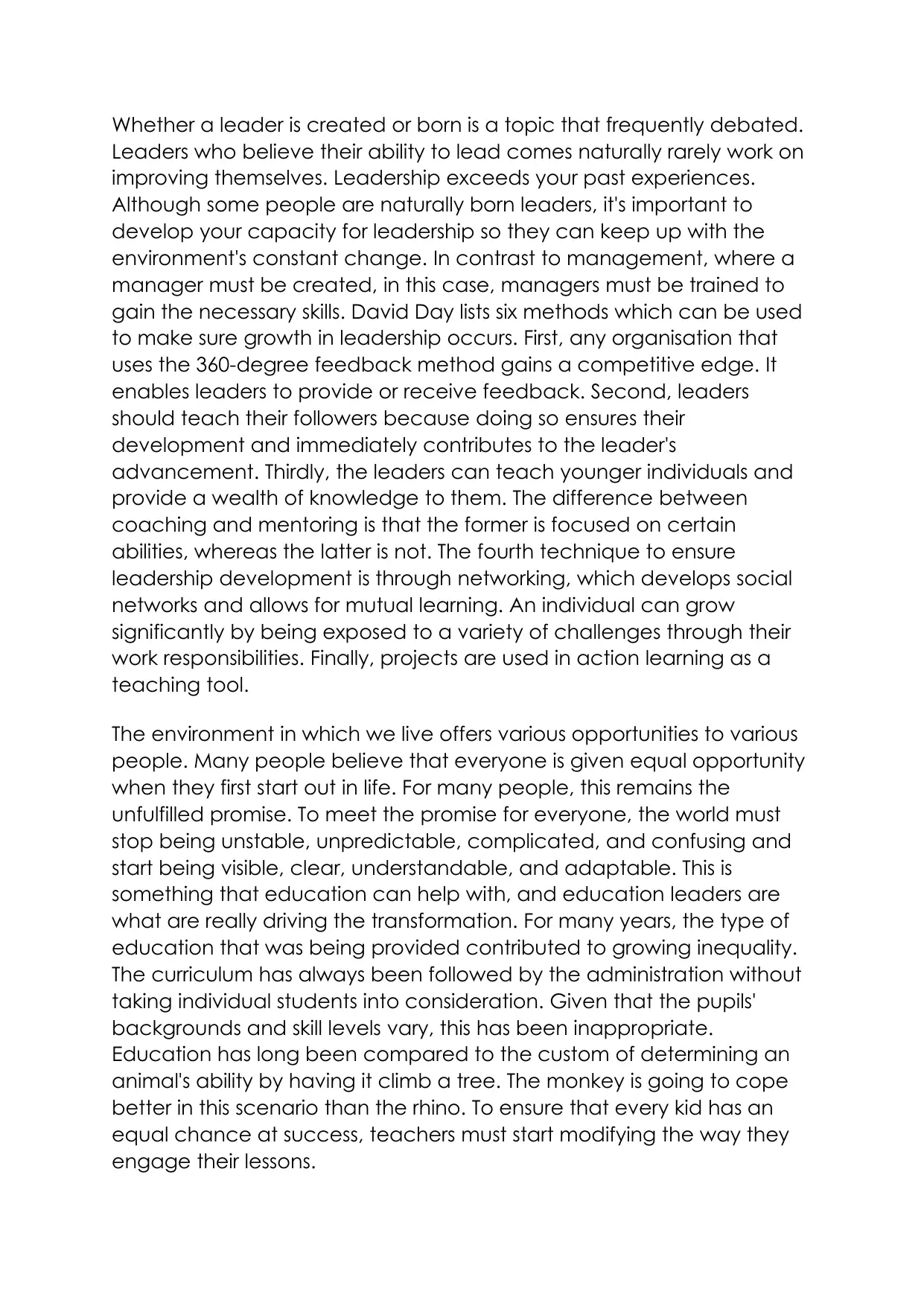
Whether a leader is created or born is a topic that frequently debated.
Leaders who believe their ability to lead comes naturally rarely work on
improving themselves. Leadership exceeds your past experiences.
Although some people are naturally born leaders, it's important to
develop your capacity for leadership so they can keep up with the
environment's constant change. In contrast to management, where a
manager must be created, in this case, managers must be trained to
gain the necessary skills. David Day lists six methods which can be used
to make sure growth in leadership occurs. First, any organisation that
uses the 360-degree feedback method gains a competitive edge. It
enables leaders to provide or receive feedback. Second, leaders
should teach their followers because doing so ensures their
development and immediately contributes to the leader's
advancement. Thirdly, the leaders can teach younger individuals and
provide a wealth of knowledge to them. The difference between
coaching and mentoring is that the former is focused on certain
abilities, whereas the latter is not. The fourth technique to ensure
leadership development is through networking, which develops social
networks and allows for mutual learning. An individual can grow
significantly by being exposed to a variety of challenges through their
work responsibilities. Finally, projects are used in action learning as a
teaching tool.
The environment in which we live offers various opportunities to various
people. Many people believe that everyone is given equal opportunity
when they first start out in life. For many people, this remains the
unfulfilled promise. To meet the promise for everyone, the world must
stop being unstable, unpredictable, complicated, and confusing and
start being visible, clear, understandable, and adaptable. This is
something that education can help with, and education leaders are
what are really driving the transformation. For many years, the type of
education that was being provided contributed to growing inequality.
The curriculum has always been followed by the administration without
taking individual students into consideration. Given that the pupils'
backgrounds and skill levels vary, this has been inappropriate.
Education has long been compared to the custom of determining an
animal's ability by having it climb a tree. The monkey is going to cope
better in this scenario than the rhino. To ensure that every kid has an
equal chance at success, teachers must start modifying the way they
engage their lessons.
Leaders who believe their ability to lead comes naturally rarely work on
improving themselves. Leadership exceeds your past experiences.
Although some people are naturally born leaders, it's important to
develop your capacity for leadership so they can keep up with the
environment's constant change. In contrast to management, where a
manager must be created, in this case, managers must be trained to
gain the necessary skills. David Day lists six methods which can be used
to make sure growth in leadership occurs. First, any organisation that
uses the 360-degree feedback method gains a competitive edge. It
enables leaders to provide or receive feedback. Second, leaders
should teach their followers because doing so ensures their
development and immediately contributes to the leader's
advancement. Thirdly, the leaders can teach younger individuals and
provide a wealth of knowledge to them. The difference between
coaching and mentoring is that the former is focused on certain
abilities, whereas the latter is not. The fourth technique to ensure
leadership development is through networking, which develops social
networks and allows for mutual learning. An individual can grow
significantly by being exposed to a variety of challenges through their
work responsibilities. Finally, projects are used in action learning as a
teaching tool.
The environment in which we live offers various opportunities to various
people. Many people believe that everyone is given equal opportunity
when they first start out in life. For many people, this remains the
unfulfilled promise. To meet the promise for everyone, the world must
stop being unstable, unpredictable, complicated, and confusing and
start being visible, clear, understandable, and adaptable. This is
something that education can help with, and education leaders are
what are really driving the transformation. For many years, the type of
education that was being provided contributed to growing inequality.
The curriculum has always been followed by the administration without
taking individual students into consideration. Given that the pupils'
backgrounds and skill levels vary, this has been inappropriate.
Education has long been compared to the custom of determining an
animal's ability by having it climb a tree. The monkey is going to cope
better in this scenario than the rhino. To ensure that every kid has an
equal chance at success, teachers must start modifying the way they
engage their lessons.
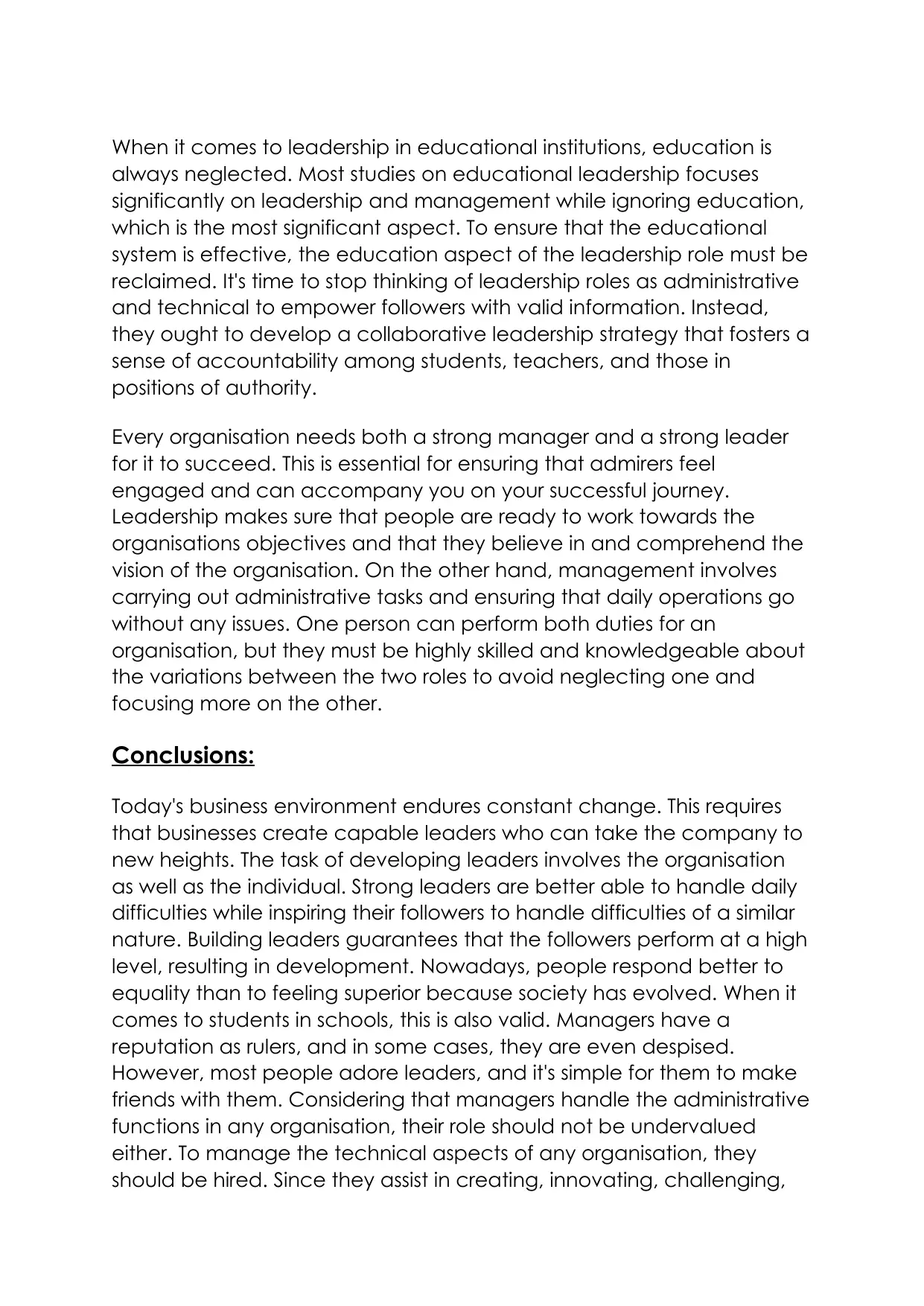
When it comes to leadership in educational institutions, education is
always neglected. Most studies on educational leadership focuses
significantly on leadership and management while ignoring education,
which is the most significant aspect. To ensure that the educational
system is effective, the education aspect of the leadership role must be
reclaimed. It's time to stop thinking of leadership roles as administrative
and technical to empower followers with valid information. Instead,
they ought to develop a collaborative leadership strategy that fosters a
sense of accountability among students, teachers, and those in
positions of authority.
Every organisation needs both a strong manager and a strong leader
for it to succeed. This is essential for ensuring that admirers feel
engaged and can accompany you on your successful journey.
Leadership makes sure that people are ready to work towards the
organisations objectives and that they believe in and comprehend the
vision of the organisation. On the other hand, management involves
carrying out administrative tasks and ensuring that daily operations go
without any issues. One person can perform both duties for an
organisation, but they must be highly skilled and knowledgeable about
the variations between the two roles to avoid neglecting one and
focusing more on the other.
Conclusions:
Today's business environment endures constant change. This requires
that businesses create capable leaders who can take the company to
new heights. The task of developing leaders involves the organisation
as well as the individual. Strong leaders are better able to handle daily
difficulties while inspiring their followers to handle difficulties of a similar
nature. Building leaders guarantees that the followers perform at a high
level, resulting in development. Nowadays, people respond better to
equality than to feeling superior because society has evolved. When it
comes to students in schools, this is also valid. Managers have a
reputation as rulers, and in some cases, they are even despised.
However, most people adore leaders, and it's simple for them to make
friends with them. Considering that managers handle the administrative
functions in any organisation, their role should not be undervalued
either. To manage the technical aspects of any organisation, they
should be hired. Since they assist in creating, innovating, challenging,
always neglected. Most studies on educational leadership focuses
significantly on leadership and management while ignoring education,
which is the most significant aspect. To ensure that the educational
system is effective, the education aspect of the leadership role must be
reclaimed. It's time to stop thinking of leadership roles as administrative
and technical to empower followers with valid information. Instead,
they ought to develop a collaborative leadership strategy that fosters a
sense of accountability among students, teachers, and those in
positions of authority.
Every organisation needs both a strong manager and a strong leader
for it to succeed. This is essential for ensuring that admirers feel
engaged and can accompany you on your successful journey.
Leadership makes sure that people are ready to work towards the
organisations objectives and that they believe in and comprehend the
vision of the organisation. On the other hand, management involves
carrying out administrative tasks and ensuring that daily operations go
without any issues. One person can perform both duties for an
organisation, but they must be highly skilled and knowledgeable about
the variations between the two roles to avoid neglecting one and
focusing more on the other.
Conclusions:
Today's business environment endures constant change. This requires
that businesses create capable leaders who can take the company to
new heights. The task of developing leaders involves the organisation
as well as the individual. Strong leaders are better able to handle daily
difficulties while inspiring their followers to handle difficulties of a similar
nature. Building leaders guarantees that the followers perform at a high
level, resulting in development. Nowadays, people respond better to
equality than to feeling superior because society has evolved. When it
comes to students in schools, this is also valid. Managers have a
reputation as rulers, and in some cases, they are even despised.
However, most people adore leaders, and it's simple for them to make
friends with them. Considering that managers handle the administrative
functions in any organisation, their role should not be undervalued
either. To manage the technical aspects of any organisation, they
should be hired. Since they assist in creating, innovating, challenging,
⊘ This is a preview!⊘
Do you want full access?
Subscribe today to unlock all pages.

Trusted by 1+ million students worldwide
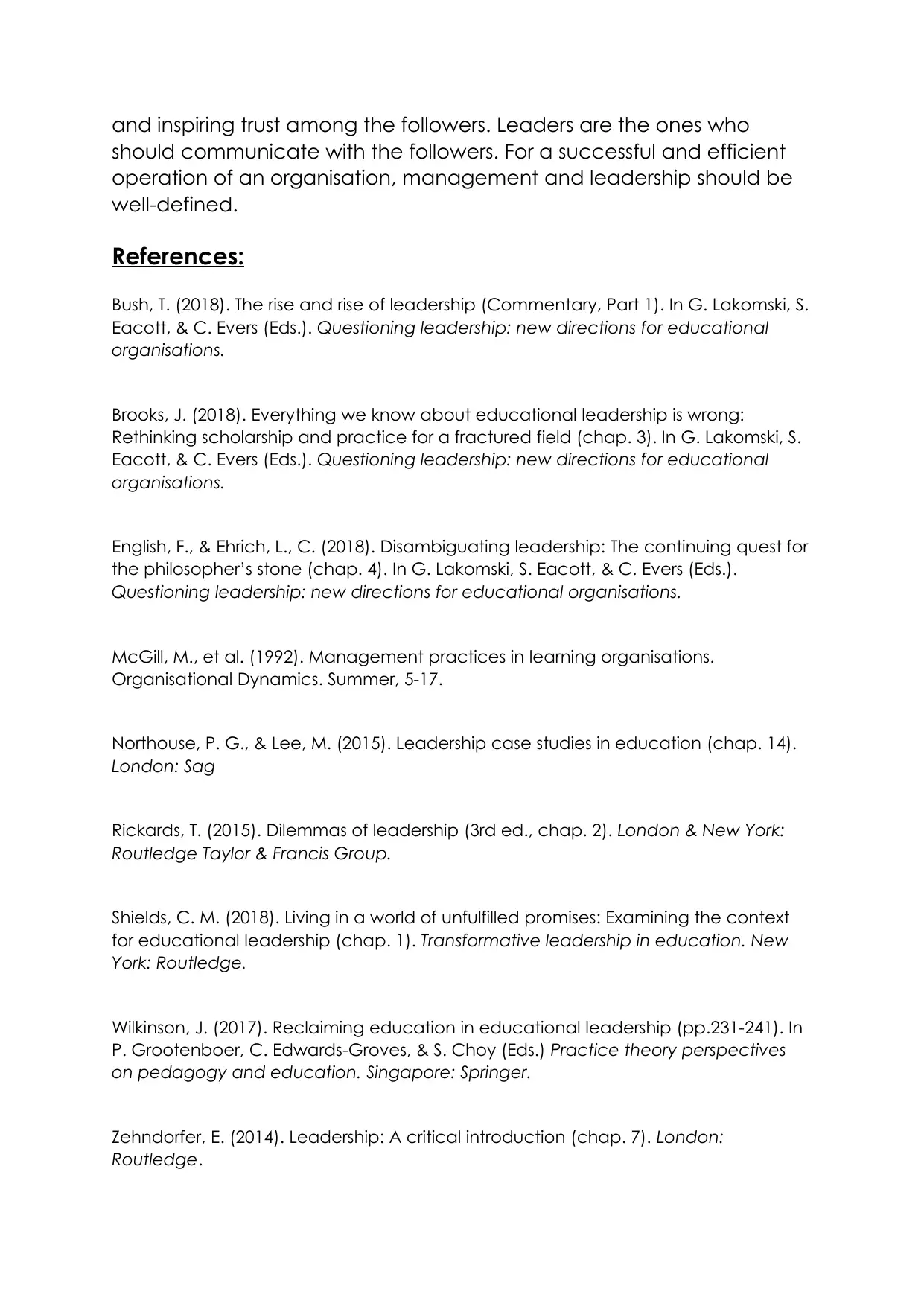
and inspiring trust among the followers. Leaders are the ones who
should communicate with the followers. For a successful and efficient
operation of an organisation, management and leadership should be
well-defined.
References:
Bush, T. (2018). The rise and rise of leadership (Commentary, Part 1). In G. Lakomski, S.
Eacott, & C. Evers (Eds.). Questioning leadership: new directions for educational
organisations.
Brooks, J. (2018). Everything we know about educational leadership is wrong:
Rethinking scholarship and practice for a fractured field (chap. 3). In G. Lakomski, S.
Eacott, & C. Evers (Eds.). Questioning leadership: new directions for educational
organisations.
English, F., & Ehrich, L., C. (2018). Disambiguating leadership: The continuing quest for
the philosopher’s stone (chap. 4). In G. Lakomski, S. Eacott, & C. Evers (Eds.).
Questioning leadership: new directions for educational organisations.
McGill, M., et al. (1992). Management practices in learning organisations.
Organisational Dynamics. Summer, 5-17.
Northouse, P. G., & Lee, M. (2015). Leadership case studies in education (chap. 14).
London: Sag
Rickards, T. (2015). Dilemmas of leadership (3rd ed., chap. 2). London & New York:
Routledge Taylor & Francis Group.
Shields, C. M. (2018). Living in a world of unfulfilled promises: Examining the context
for educational leadership (chap. 1). Transformative leadership in education. New
York: Routledge.
Wilkinson, J. (2017). Reclaiming education in educational leadership (pp.231-241). In
P. Grootenboer, C. Edwards-Groves, & S. Choy (Eds.) Practice theory perspectives
on pedagogy and education. Singapore: Springer.
Zehndorfer, E. (2014). Leadership: A critical introduction (chap. 7). London:
Routledge.
should communicate with the followers. For a successful and efficient
operation of an organisation, management and leadership should be
well-defined.
References:
Bush, T. (2018). The rise and rise of leadership (Commentary, Part 1). In G. Lakomski, S.
Eacott, & C. Evers (Eds.). Questioning leadership: new directions for educational
organisations.
Brooks, J. (2018). Everything we know about educational leadership is wrong:
Rethinking scholarship and practice for a fractured field (chap. 3). In G. Lakomski, S.
Eacott, & C. Evers (Eds.). Questioning leadership: new directions for educational
organisations.
English, F., & Ehrich, L., C. (2018). Disambiguating leadership: The continuing quest for
the philosopher’s stone (chap. 4). In G. Lakomski, S. Eacott, & C. Evers (Eds.).
Questioning leadership: new directions for educational organisations.
McGill, M., et al. (1992). Management practices in learning organisations.
Organisational Dynamics. Summer, 5-17.
Northouse, P. G., & Lee, M. (2015). Leadership case studies in education (chap. 14).
London: Sag
Rickards, T. (2015). Dilemmas of leadership (3rd ed., chap. 2). London & New York:
Routledge Taylor & Francis Group.
Shields, C. M. (2018). Living in a world of unfulfilled promises: Examining the context
for educational leadership (chap. 1). Transformative leadership in education. New
York: Routledge.
Wilkinson, J. (2017). Reclaiming education in educational leadership (pp.231-241). In
P. Grootenboer, C. Edwards-Groves, & S. Choy (Eds.) Practice theory perspectives
on pedagogy and education. Singapore: Springer.
Zehndorfer, E. (2014). Leadership: A critical introduction (chap. 7). London:
Routledge.
1 out of 7
Related Documents
Your All-in-One AI-Powered Toolkit for Academic Success.
+13062052269
info@desklib.com
Available 24*7 on WhatsApp / Email
![[object Object]](/_next/static/media/star-bottom.7253800d.svg)
Unlock your academic potential
Copyright © 2020–2025 A2Z Services. All Rights Reserved. Developed and managed by ZUCOL.




